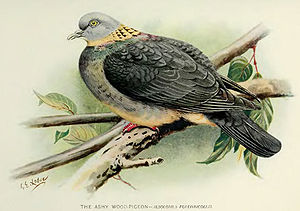Himalayan pigeon
| Himalayan pigeon | ||||||||||
|---|---|---|---|---|---|---|---|---|---|---|

Himalayan pigeon |
||||||||||
| Systematics | ||||||||||
|
||||||||||
| Scientific name | ||||||||||
| Columba pulchricollis | ||||||||||
| Blyth , 1846 |
The Himalayan pigeon ( Columba pulchricollis ), also known as the Nepalese pigeon , is a species of pigeon birds . It occurs only in East Asia.
Appearance
The Himalayan pigeon reaches a body length between 30 and 35 centimeters. It is a little bigger than a city pigeon, but has a somewhat slimmer build compared to this. The gender dimorphism is only very slightly pronounced. The females are usually a bit smaller. In the male, the plumage is usually a little lighter, the shade of blue a little more pronounced.
The males of the Himalayan pigeon have a blue-gray head, neck and back. The throat is light. A wide, light orange band runs across the back of the neck. This becomes narrower on the sides of the neck. The chest is dark blue-gray. The plumage on the belly brightens to a light blue-gray. The wings of the hand are dark. The under tail coverts are cream colored. The beak is red at the base and turns green towards the tip. The iris is light green. The eyes have a light blue border. The females differ from the males by a pure white throat and slightly more matt colors.
Distribution area and behavior
The Himalayan pigeon is found in Tibet, Nepal, Assam, western Bengal and Bangladesh, Burma, Thailand and Taiwan. It lives at altitudes between 1,300 and 3,000 meters and thus significantly lower than the snow pigeon , which, like the Himalayan pigeon, belongs to the Columbinae subfamily . Their food spectrum includes fruits and seeds. Blackberries and raspberries, which grow very abundantly in the area of distribution, play a large part in their food spectrum. In a shot pigeon, however, the goiter was mostly filled with small snails and very few seeds. The clutch consists of only one egg. The breeding season is 21 to 23 days.
Keeping in human care
The pigeon was only imported to Germany in 1984. The owner succeeded in first breeding in the same year. Since then, however, the Himalayan pigeon has become more widespread in wild pigeon keeping. In 1994 94 young birds of this species were reared in Germany, in 1995 there were 84 young birds. However, because of its size, it needs a very spacious aviary.
supporting documents
Individual evidence
literature
- David Gibbs, Eustace Barnes and John Cox: Pigeons and Doves - A Guide to the Pigeons and Doves of the World . Pica Press, Sussex 2001, ISBN 90-74345-26-3 .
- Alois Münst and Josef Wolters: Tauben - The species of wild pigeons , 2nd expanded and revised edition, Verlag Karin Wolters, Bottrop 1999, ISBN 3-9801504-9-6 .
- Gerhard Rösler: The wild pigeons of the earth - free life, keeping and breeding , Verlag M. & H. Schaper, Alfeld-Hannover 1996, ISBN 3-7944-0184-0 .
Web link
- Columba pulchricollis inthe IUCN 2013 Red List of Threatened Species . Listed by: BirdLife International, 2012. Retrieved October 30, 2013.